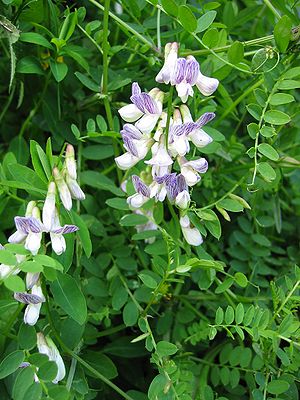Forest vetch
| Forest vetch | ||||||||||||
|---|---|---|---|---|---|---|---|---|---|---|---|---|

Forest vetch ( Vicia sylvatica ) |
||||||||||||
| Systematics | ||||||||||||
|
||||||||||||
| Scientific name | ||||||||||||
| Vicia sylvatica | ||||||||||||
| L. |
The forest-vetch ( Vicia sylvatica ) is a plant that the subfamily Pea (Faboideae) within the family of legumes belongs (Fabaceae or Leguminosae). It is widespread in Eurasia .
description
Appearance and leaf
The forest vetch is a perennial herbaceous plant . It has long subterranean runners . The four-edged, furrowed, bare stems are usually about 1 to 2, rarely up to 4 meters long, slack and climbing or prostrate.
The alternate leaves are pinnate in pairs with usually six to nine, rarely five or ten pairs of pinnate leaves. The leaves end in a tendril . The stipules are half-kidney-shaped to crescent-shaped, deeply split into seven to ten long awning tips (only the uppermost often with entire margins).
Inflorescence and flower
The flowering period extends from June to September. usually 10 to 15 (5 to 20) nodding flowers are grouped together in one-sided racemose inflorescences (in very shady locations, arm - flowered ).
The hermaphrodite flowers are zygomorphic and five-fold with a double flower envelope . The petals are whitish with a blue-violet veined (rarely completely white or purple) flag and usually violet tip of the boat.
Chromosome number
The number of chromosomes is 2n = 14.
ecology
The vegetative reproduction happens through underground runners .
The pollination is carried out by vigorous bees .
Occurrence and endangerment
The forest vetch is widespread in Eurasia . It occurs from southern France to Siberia . In Europe, the forest vetch is widespread in the Alps , especially in the northern chains, but can also be found in southern France as far as the Balkans , northern Europe.
The forest vetch thrives at altitudes between about 600 to 2300 meters. In the Allgäu Alps, it rises to over 2000 meters above sea level. The preferred locations are fresh forests, forest edges, woodlands, tall herbaceous vegetation from the montane to subalpine altitude . In Central Europe it is a character species of the Vicietum-sylvaticae-dumetorum from the association Trifolion medii.
In Austria the forest vetch can be found scattered (absent in Burgenland and Vienna ).
In Germany, the forest vetch occurs in the Swabian Alb and in the Hegau ; It is moderately common in the southern Neckar basin , in Franconia , in Thuringia , in southwest Saxony-Anhalt , in southeast Lower Saxony ; it occurs scattered in the Alps as well as in southern Saxony ; only very scattered in Mecklenburg-Western Pomerania , north-eastern Brandenburg , eastern Southern Upland and Teutoburg Forest ; very rare in the Odenwald and Spessart ; There are individual finds in the foothills of the Alps and in the Rhineland . In the Red List of Germany it is not considered endangered, in the federal states Baden-Württemberg, Bavaria, Lower Saxony, Thuringia, Mecklenburg-Western Pomerania, Saxony-Anhalt and Saxony it is rated as not endangered; in Brandenburg and Hesse it is potentially endangered; in North Rhine-Westphalia it is considered endangered and in Schleswig-Holstein it is endangered.
In Switzerland it occurs in the northern Alps, in Graubünden , in western Valais, in the northern Jura, and rarely in the Central Plateau and Ticino (Salève, Reculet).
Systematics
The first publication of Vicia sylvatica was made in 1753 by Carl Linnaeus in Species Plantarum , 2, S. 734th
Vicia sylvatica belongs to the section Vicilla from the subgenus Vicilla in the genus Vicia .
literature
- Xaver Finkenzeller, Jürke Grau: Alpine flowers. Recognize and determine (= Steinbach's natural guide ). Mosaik, Munich 2002, ISBN 3-576-11482-3 .
- Wolfgang Adler, Karl Oswald, Raimund Fischer: Excursion flora of Austria . Ed .: Manfred A. Fischer. Eugen Ulmer, Stuttgart / Vienna 1994, ISBN 3-8001-3461-6 .
Individual evidence
- ↑ a b c Entry in International Legume Database & Information Service = ILDIS.
- ↑ a b c d data sheet at Botanik im Bild / Flora of Austria, Liechtenstein and South Tyrol , November 21, 2011.
- ↑ a b Erich Oberdorfer : Plant-sociological excursion flora for Germany and neighboring areas . 8th edition. Verlag Eugen Ulmer, Stuttgart 2001, ISBN 3-8001-3131-5 . Page 611.
- ↑ a b Ruprecht Düll , Herfried Kutzelnigg : Pocket dictionary of the plants of Germany and neighboring countries. The most common Central European species in portrait. 7th, corrected and enlarged edition. Quelle & Meyer, Wiebelsheim 2011, ISBN 978-3-494-01424-1 .
- ↑ a b c Vicia sylvatica in the Germplasm Resources Information Network (GRIN), USDA , ARS , National Genetic Resources Program. National Germplasm Resources Laboratory, Beltsville, Maryland. Retrieved July 23, 2013.
- ↑ Erhard Dörr, Wolfgang Lippert : Flora of the Allgäu and its surroundings. Volume 2, IHW, Eching 2004, ISBN 3-930167-61-1 , p. 153.
- ↑ Data sheet from Flora von Deutschland - A picture database , Version 2.32 by Michael Hassler and Bernd Schmitt.
- ↑ Data sheet at InfoFlora, the national data and information center for Swiss flora .
Web links
- Forest vetch. In: FloraWeb.de.
- Forest vetch . In: BiolFlor, the database of biological-ecological characteristics of the flora of Germany.
- Profile and distribution map for Bavaria . In: Botanical Information Hub of Bavaria .
- Vicia sylvatica L. In: Info Flora , the national data and information center for Swiss flora . Retrieved November 22, 2015.
- Distribution in the northern hemisphere according to Eric Hultén
- Thomas Meyer: Data sheet with identification key and photos at Flora-de: Flora von Deutschland (old name of the website: Flowers in Swabia )


